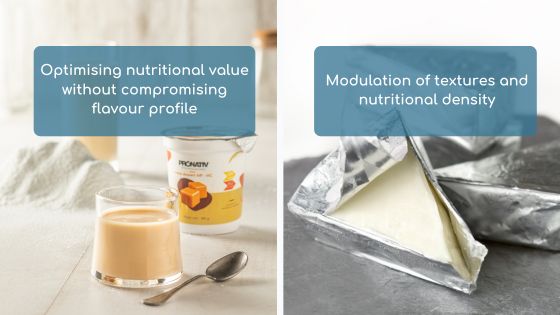
How to ensure the right balance between eating pleasure and nutrition for vulnerable people
Individuals referred to as vulnerable include young children, disabled people, people with medical conditions and older people. Their nutritional vulnerability generates major risks: deficiencies, undernutrition, and even pathologies such as sarcopenia or osteoporosis. Nutrition for vulnerable people is therefore becoming a major public health issue. Faced with these challenges, reconciling nutrition and eating pleasure is becoming a key challenge for the food industry.
Nutrition for vulnerable people: overview and associated challenges
Young children
Worldwide, nearly 149 million children under the age of 5 suffer from stunted growth (2022).[1] Yet growth in children is closely linked to diet, which is directly dependent on the intake of essential nutrients (calcium, proteins etc.).[2] Good nutrition at this stage of life is therefore essential to ensure optimal physical and cognitive development.
Disabled people
Around 1.3 billion people, or 16% of the world’s population, live with a disability. Many of these people suffer from disorders such as dysphagia, a difficulty in swallowing that complicates their independent eating. In addition, there is often an imbalance between nutritional requirements and real intake, as well as difficulties in expressing hunger or thirst. These factors considerably increase the risk of undernutrition, with major consequences for overall health and quality of life.

People with medical conditions
People suffering from acute or chronic illnesses often experience a weakening of the immune system and a drop in energy levels, leading to an increase in their nutritional requirements, particularly in terms of proteins, vitamins and minerals. This readjustment supports their metabolism, promotes recovery and strengthens their immune defenses.[1] In France, it’s estimated that around 40% of cancer patients are undernourished.[2] This condition has particularly serious consequences in oncology, since it reduces the efficacy of chemotherapy, impairs patients’ quality of life and significantly increases the risk of post-operative and post-chemotherapy morbidity and mortality.[3]
Older people
Nutrition for vulnerable people concerns all age groups, including older people, for whom aging can lead to specific pathologies such as sarcopenia. This pathology is characterized by a progressive loss of muscle mass and strength, and is expected to affect around 18.7 million people in Europe by 2045, according to Eurostat projections.[1] Sarcopenia is also a risk factor for dysphagia, as it reduces the strength of the oropharyngeal muscles which are essential for swallowing. These swallowing disorders then disrupt dietary intake, particularly proteins, which contributes to aggravated sarcopenia,[2] creating a vicious circle that is detrimental to the health and autonomy of older people.
Nutrition and eating pleasure: a delicate balance with real-life consequences
Young children
According to UNICEF data, a number of inappropriate nutritional practices among young children, such as late introduction of solid foods or lack of dietary diversity, deprive them of essential nutrients at a key stage in their development.[1] Added to this are factors such as food neophobia, which hinders acceptance of new foods, or digestive disorders, which exacerbate nutritional imbalances. These observations highlight the importance of taking these issues into account right from the formulation stage of products aimed at this vulnerable segment of the population. Eating pleasure then becomes an essential lever for introducing foods that are appealing, tasty and nutritious, thus promoting better habits from an early age.

Disabled people
Around 60% of people with multiple disabilities suffer from undernutrition,[1] a condition that seriously compromises their health and quality of life. Texture-modified foods, often necessary to facilitate swallowing, are often visually unappealing and unappetizing in taste, reducing eating pleasure and leading to a reduction in nutritional intake. This nutritional insufficiency further compounds the physical dependence of the people concerned, accentuating muscle wasting and fatigue. It also favors the onset of medical complications, such as respiratory or urinary tract infections, due to a weakened immune system. Palatability and the quality of textures are therefore essential levers for combining gustatory pleasure and appropriate nutrition in the care of these vulnerable populations.
People with medical conditions
Up to 70% of patients treated with chemotherapy suffer from taste disorders,[1] which considerably impair eating pleasure. This loss of eating pleasure often leads to a reduction in appetite, making eating more difficult and insufficient. In the long term, this drop in intake can compromise tolerance to treatment,6 worsening the patient’s general condition. It is therefore essential to offer an enriched and adapted diet, which does not overlook the organoleptic dimensions (taste, texture, appearance) in order to maintain the desire to eat and effectively support treatment.
Older people
In older people, chewing and swallowing difficulties, often linked to oral health problems or dysphagia, limit the consumption of protein-rich foods such as meat. At the same time, hormonal and sensory changes associated with aging (diminished sense of taste and smell, faster feeling of satiety) reduce the desire to eat, leading to what is known as anorexia of aging. To guarantee an adequate daily protein intake, recommended at a minimum of 1 g/kg of body weight,[1] an integrated approach is required: nutritional enrichment of meals, adaptation of textures and an increased emphasis on eating pleasure. In this context, the use of dairy proteins represents a particularly relevant way to improve the protein status of food preparations intended for senior consumers, thus helping to maintain their autonomy and quality of life.
Dairy proteins: a lever for innovation to reconcile nutrition and eating pleasure
Creating gourmet desserts rich in high-quality proteins
Ready-to-drink milk drinks, high-protein mousses and cream desserts are particularly popular formats, both with children and older people. Enriching these products with high-quality proteins, such as Pronativ® native whey proteins, optimizes their nutritional value without compromising their aromatic profile. Thanks to their functional properties, native milk proteins also facilitate the creation of appealing and adapted textures, while meeting the specific needs of different groups of individuals. Pronativ® native whey is particularly rich in leucine, a key amino acid in muscle synthesis, making it ideal for supporting growth in children and preventing sarcopenia in older people.[1] In the same context, Pronativ® native micellar caseins are ideal for formulating low-viscosity, high-protein oral nutritional supplements.

Optimizing textures and nutritional density with LACTALIS caseins
Desserts, processed cheeses and creamy purees are foods that can be easily integrated into the daily diet. They therefore represent real opportunities for improving the protein status of vulnerable people. Using LACTALIS caseins not only enriches these preparations with high-quality proteins, but also modulates their texture to meet the specific preferences and needs of the target consumer, ensuring both better nutrition and optimal taste acceptability.
Conclusions
Nutrition for vulnerable people requires solutions that combine eating pleasure, safety and nutrition. Dairy proteins, with their functional and nutritional properties, offer innovative solutions for these segments of the population. Lactalis Ingredients offers ranges designed to meet tomorrow’s challenges in clinical and specialized nutrition.
A question ? Contact-us !
Sources:
[1] UNICEF, Malnutrition, 2024, disponible en ligne : Malnutrition
[2] OMS, Alimentation saine, 2020, disponible en ligne : Alimentation saine
[3] OMS, Infirmité, 2023, disponible en ligne : Organisation mondiale de la Santé, 2022 – World Report on Disability
[4] OMS, Diet, nutrition and the prevention of chronic diseases: report of a joint WHO/FAO expert consultation, 2003.
[5] Ligue contre le cancer, 2023, La dénutrition c’est quoi ?[6] Eric Van Cutsem et al., Les causes et les conséquences de la malnutrition associée au cancer, 2005.
[7] Ethgen et al., La prévalence future de la sarcopénie en Europe : une revendication pour une action de santé publique, 2016.
[8] Hélio José Coelho-Junior et al., L’apport en protéines et la sarcopénie chez les personnes âgées : revue systématique et méta-analyse, 2022.
[9]UNICEF, Cinq enfants sur six âgés de moins de deux ans ne reçoivent pas un apport nutritionnel suffisant pour assurer leur croissance et le développement de leur cerveau – UNICEF, 2016.
[10] Association Ressources Polyhandicap Hauts-de- France, Fiches santé polyhandicap, 2021.
[11] Spotten et al., Subjective and objective taste and smell changes in cancer, 2017.
[12] Anses, Actualisation des repères alimentaires du PNNS pour les femmes dès la ménopause et les hommes de plus de 65 ans, 2019.
[13] Martinez-Arnau et al., Effets bénéfiques de la supplémentation en leucine sur les critères de sarcopénie : une revue systématique, 2019.















